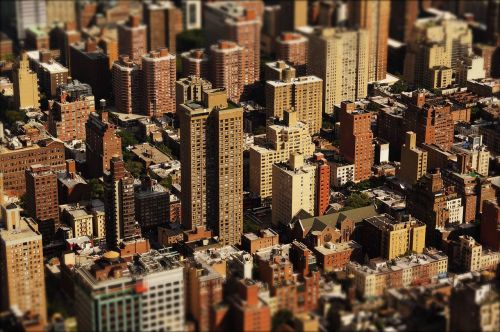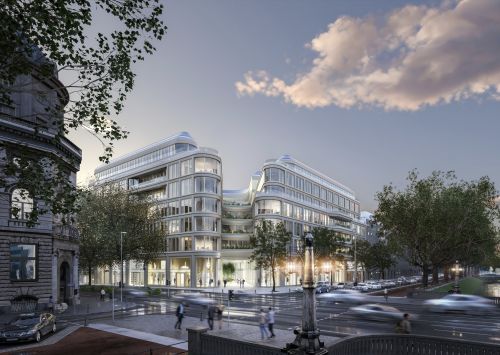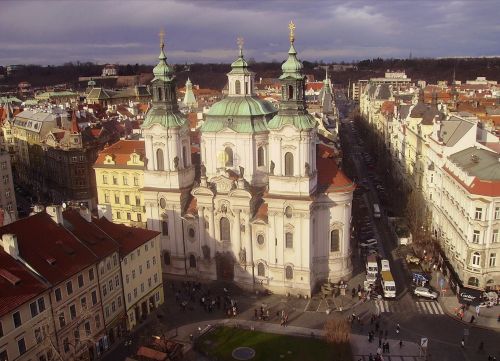Originality worth its weight in gold
Retail & leisure
Competitive advantage or rather competitive advantages are significant factors on the Polish retail market. With the growing stock of shopping centres and the construction of the various different formats of facilities, even in smaller towns, the remaining niches are being filled, and so developers are left with no choice but to try to make themselves more distinct from their rivals. There are many points that such activities can start from, including: the location and character of the place, the operating climate and an observation of shopping habits. Griffin Real Estate is the developer of Hala Koszyki, a market hall that was built in 1906–1909 at ul. Koszykowa 61/63 in central Warsaw. The company purchased the building in 2012 from Avestus Real Estate (formerly Quinlan Private Golub) with the intention of reconstructing it. “Since that time we have been thinking about how to bring Hala Koszyki back to life. So we decided to give it retail and office functions. Together with the monuments preservation board, which was to supervise the project, we were wondering how to carry out the entire process. The retail area could have just been another typical shopping centre – or something more sophisticated. Our first few drawings envisaged a mini shopping centre with an area of app. 10,000 sqm. However, after some further consideration we came to the conclusion that this would not work. It would not reach a critical mass and would not be able to hold its own against the competition,” explains Michał Świerczyński, a venture partner and head of retail at Griffin Real Estate. After some reconnaissance and analysis the investor decided to retain the market character of Hala Koszyki, but present it to the residents of Warsaw in a completely different form. At the end of September and early October, when the opening of the complex is planned, it will be possible to evaluate the effects of the owner’s efforts in travelling across the whole of Europe looking for the inspiration for the new concept. Capital Park, the developer of ArtN in Warsaw’s Wola district, also decided to tap into the magic of its location. The project is to be developed on the site of the former Norblin factory and will combine retail space divided into a number of shopping zones and office functions. Unibail-Rodamco has also spared no effort in making its shopping centres more attractive. The company is planning the redevelopment of the Arkadia mall in the capital’s Żoliborz district, where it is planning to add to the quality of its restaurant offer by relaunching it as the Dining Plaza zone as well as rebranding a section of Galeria Mokotów across the city as The Designer Gallery. Both projects are based on the Destinations concept, which involves setting up unique meeting places in shopping centres.
Inside the kitchen
Such new retail formulas are mostly, but not exclusively, based on the catering range in shopping centres, which is currently becoming more and more important. The role of the food court in a typical mall has been taking on an increasing significance. This can be seen from the number of food court modernisations taking place (e.g. Pasaż Grunwaldzki in Wrocław, Galeria Jurajska inCzęstochowa, Wola Park in Warsaw, Aura Centrum in Olsztyn, Focus Mall in Bydgoszcz and the changes planned for Silesia City Center in Katowice). Consumer trends indicating that Poles are eating out more often are being taken on board. “Surveys show that expenditure has been growing in this respect. Consumers are also increasingly aware of what they eat. We are appreciating the quality of grocery products more and the consumption of fine wines and quality meat has been increasing – and this knowledge was employed for the concept for Hala Koszyki,” explains Michał Świerczyński. The investor’s team went on a European tour in the course of their preparations, travelling to places famous for combining gastronomic and retail functions, so they could familiarise themselves with the best ideas and apply them to Polish conditions. “At the moment, global retail trends are based on looking for new approaches. There are more and more covered markets in Germany, London, Manchester and New York. We were looking for something that was part of the street, which reflected the original character of the city’s life. Hala Koszyki will be such a place. However, in order to get there, we first of all had to look at how these centres operated, what made them unique. To do this we chose a few projects in Europe. We visited Mathallen in Oslo, an old factory that has been transformed into a place filled with eateries. In the middle of its central section there is a bar and some shared seating, surrounded by bars offering espressos, wine and freshly made juice. Messages are chalked on the blackboards there every day, thanks to which you do not get that feeling that you are in a shopping mall. Another destination was an old tram terminal in Amsterdam, which now houses Foodhallen. This features two waiter service restaurants and a variety of 40 stalls offering cuisine from across the world. We also went to Mercato Centrale in Florence, a modernist-style hall with a covered market on the ground floor, and a central bar offering coffee, wines, beers and local food on the upper floor, which is surrounded by a number of local restaurants and wine stores. Mercado de San Antón and Mercado de San Miguel in Madrid feature succulent flavours in the form of an open kitchen, combined with stalls selling local produce. In Mercado da Ribeira in Lisbon we were impressed by the modest architecture, the restaurants opened up to the area of the hall, the shared seats and the stalls selling wine, champagne, coffee, juices and soft drinks. You can also eat in restaurants owned by famous chefs. It is open 24 hours a day,” effuses Michał Świerczyński.
After such an introduction, what was the final concept for Hala Koszyki that was decided upon? It should continue to attract local residents, and to fill in and extend the street in Warsaw. It is also intended to become a culinary showpiece of the city. “We can see how Warsaw has been growing in terms of good cuisine, how many new concepts are appearing here. These are often sophisticated cuisines, sometimes a particular chef’s creation, and of a high standard. Streets such as Wilcza, Poznańska and pl. Zbawiciela are becoming vibrant in a culinary sense. You can hear the street noise just like in Western Europe. Hala Koszyki will be exactly the same – it will integrate with the character of the street and become a good meeting place, a place of culinary discovery,” claims Michał Świerczyński. It will offer a variety of cuisines, which are to complement rather than cannibalise each other. A central bar will be positioned in the middle of the hall and will offer 250 seats and 50 standing places. Its range will include a great selection of coffees, snacks, wines, beers and aperitifs. The bar will be surrounded by a number of formats of gastronomic outlets, offering Italian, Spanish, Thai, Mexican, Indian, vegetarian and vegan food, among others. Apart from that fish dishes will be available, as well as breakfasts, lunches, pancakes, burgers and a restaurant of a popular well known chef with three concepts within one large area. Hala Koszyki will also include eleven stores: a Piotr i Paweł supermarket with a new fresh produce concept, a bakery, a butcher, a patisserie, a tea house, an ice cream parlour, a Rossmann drugstore, a travel agency, a dry cleaner and a true market. It will include specialist stalls offering a range of products (seasonal or all-year). A central square and two patios at the back of the centre also form part of the design. “None of the culinary and shop concepts (apart from Piotr i Paweł and Rossmann) form part of any major chains, but they are not experiments either. We negotiated with over 200 producers and restaurant owners who have already had some experience in the business. The selection of the tenants took three years. Together we looked at the best formulas for this specific building. We chose the best restaurant owners, who are famous for their good cuisine as well as their culinary and business skills and are popular with customers,” insists Michał Świerczyński. Hala Koszyki is now virtually fully-leased, with just the last three contracts still to be signed. Work on the architecture of the individual units as well as the supervision of the tenants’ fit-out work is currently in progress. The company wants to be able to unveil all of its tenants in the summer, during a special event devoted to Hala Koszyki. Apart from that, the investor is also providing premises for culinary academies, exhibitions, events and author meetings.
The magic of the place
New features that are not limited to the gastronomic field could also be introduced in standard shopping centres. This is the policy of Unibail-Rodamco, which has been introducing the Destinations concept to its centres across the world. This involves treating the mall as the ideal place for spending time and holding meetings. “The Destinations concept is based on the belief, supported by long-term observation, that customers come to shopping centres not only to shop but also to enjoy themselves: to meet their friends, eat something or go to the cinema. Therefore features that make the shopping process more pleasant are of key importance,” explains Jakub Skwarło, the director of operations in Central Europe at Unibail-Rodamco. As far as the food court is concerned, the company is introducing the Dining Plaza and Fresh! concepts. The former will be available to the customers of Warsaw’s Arkadia shopping centre next year. Work on the redevelopment and extension of the mall is just starting and will result in an additional 2,000 sqm. This will allow an area to be created for the introduction of the Dining Plaza concept on the first floor. The company has already implemented the concept in some of its centres across Europe. “Dining Plaza is unique in terms of interior design and the varied restaurant area, which is separated from the rest of the shopping centre. The Dining Plaza zones are designed in a way that makes it possible for customers to find somewhere to eat a family meal as well the ideal place for business or social meetings. As far as the architecture is concerned, we have focused on spaciousness, having a large number of plants and elegance, and we are also creating areas for children and places suitable for culinary events, shows, etc,” adds Jakub Skwarło. In Arkadia the Dining Plaza section will include eight restaurants (the largest will occupy an area of 1,200 sqm). The new façade of the facility will be made of glass and will include sunshading, thanks to which the interior will have good access to natural light and a panoramic view. Some restaurants will have terraces, mainly the indoor ones. Furthermore, the Unibail-Rodamco group is developing the Fresh! Concept, which involves market stalls offering fresh produce inside the shopping centre.
Different is better
Nonetheless, there are many more ways to differentiate a shopping centre from its competition – and these are not limited to the food court. Unibail-Rodamco has devised a number of approaches in response to consumer trends. These include: The Family Experience, which focuses on play areas, children’s cartoons and mother-and-baby rooms; Shopping Breaks, which guarantees comfortable relaxation areas for customers; and Click & Services – a special service area that offers consultations with stylists, a virtual changing room and a collection of products ordered online earlier (click & collect). The company is also setting up The Designer Gallery in Galeria Mokotów in Warsaw. The work on the new interior design has now started. It will cover an area of 1,800 sqm and should be completed in November. Investment costs for the project are estimated at PLN 10 mln. The zone will comprise 33 shops (including pop-ups, concept stores and fashion brands that have so far not been available in Poland), as well as an additional area of 50 sqm designated for events held by tenants and strictly related to fashion and art. Unibail-Rodamco has decided to work with Katarzyna Sokołowska on the new project. “In the case of Galeria Mokotów, we are focusing on the positioning of the mall as a fashion centre, developing The Designer Gallery, in which our current range of Polish and foreign designers will be extended to shops such as: pop-up stores, concept stores and fashion brands new to the Polish market – for instance, & Other Stories,” emphasises Jakub Skwarło. As he goes on to add: “The active management of the property portfolio, the immediate response to shopping trends and the introduction of new features are not just a choice but mostly a need. The market is becoming more and more competitive and customers more demanding. Therefore only novel and surprising concepts can keep a centre attractive among tenants and customers alike. As far as the ideas developed by us are concerned, they have been welcomed and the synergy effect that stems from them is evident. A wide retail offer combined with additional services and an event programme increases the attractiveness of the centre in customers’ eyes. At the same time, a higher number of customers makes tenants choose a given centre more often,” argues Jakub Skwarło.
Acquiring a competitive advantage is also crucial when it comes to centres that operate on difficult markets, such as Wrocław. The owners of the shopping centres that have operated in the city for some time have been making efforts to give them a greater element of specialisation (as has been the case with the Renoma department store). Other options include extensions and modernisations, such as with Magnolia Park and Pasaż Grunwaldzki.
For example, Renoma, which has been an important retail landmark in the city since it was built in 1930. In its lifetime, the building has been through several rocky moments, such as its nationalisation. In 2009 a new section was built and the entire facility renovated and repositioned. Its commercialisation took place during the credit crunch, which had a major impact on its tenant mix. “When we bought the building in 2012, our plan was to restore the reputation it had enjoyed due to its architecture, location and potential. Renoma had a rather chaotic range and was thus not so attractive when compared to the strong competition in Wrocław. We decided to create an alternative shopping centre. We terminated all the leases that were not working out and only focused on mid-range and top-shelf fashion. We replaced 50 stores in three years, introducing 24 new brands. Renoma is now fully leased, but mainly offers fashion as well as interior design goods. We have 40 shops that operate exclusively in Renoma and in almost half of them the products vary from what other shopping centres can offer. This has helped to generate an annual footfall growth of 8 pct. Tenants’ turnover has also increased. We have a list of companies that are now interested in leasing space in our centre,” boasts Michał Świerczyński of Griffin Real Estate, which owns Renoma.
Seven recipes for retail success
The Capital Park group came up with yet another novel idea to give an edge to its ArtN retail and office complex, which is to be built on ul. Żelazna in Warsaw. The retail section is to be divided into seven shopping zones, all which have been devised through taking on board changing shopping habits. They have been matched to the lifestyles of potential customers and their consumer behaviour, and include: Slow Fashion (which also covers niche brands), Taste & Experience (a zone based around sampling and experiencing, i.e. cafés and restaurants, BioBazar and culinary workshops), Flagship & Concept Stores (offering unique concepts from retail chains), Hi-Tech (focused on new technology: including technological showrooms and shops featuring modern forms of retail, such as click & collect), Leisure & Hobby, Health & Wellness as well as Convenience (everyday shopping and services, e.g. for office tenants). “The main idea behind the revitalisation of the former Norblin factory was its dualism. Combining revitalised buildings with modern architecture and consciously contrasting them, juxtaposing the office function with the retail, cultural and social functions, to create an offer for the so-called ‘retro-modern’ consumer. When we were drawing up the concept for the ArtN project, we decided that it had to stand out from other Warsaw mixed-use complexes. Our team was tasked with developing an innovative commercialisation method, not only because of the unique architecture of the former Norblin factory, but also because of ever-changing consumer tastes. They are no longer just interested in buying new collections, but also in the experience and lifestyle involved in shopping. Our inspiration came from places such as King’s Cross in London, High Line Park in the Meatpacking District in New York and Mercado de San Miguel in Madrid, which represent a completely new approach to customers. The slogan of the ArtN project is ‘Make Stories not Stores’,” explains Kinga Nowakowska, the director of the revitalisation project of the former Norblin factory and operations director of the Capital Park group. The developer is aiming for ArtN to become a place where shoppers will be able to find brands that have so far been unavailable in other retail facilities as well as popular brands but with completely new concepts, in line with the unique atmosphere of the post-industrial buildings.





















































